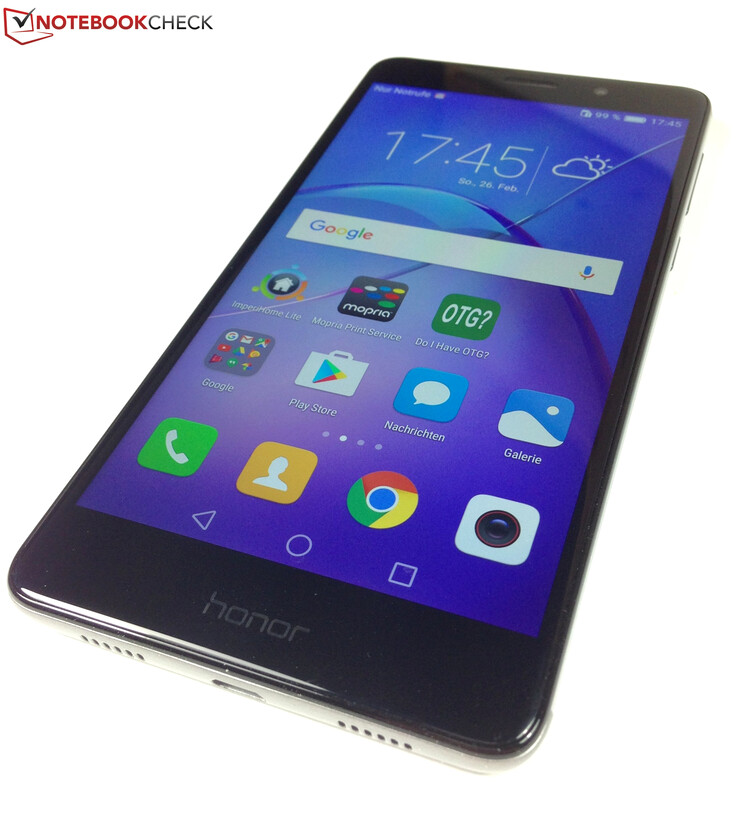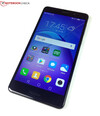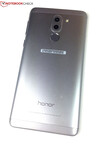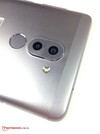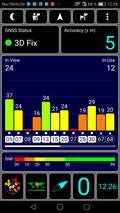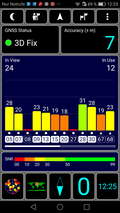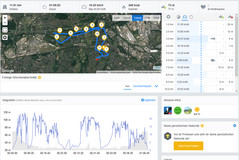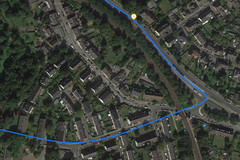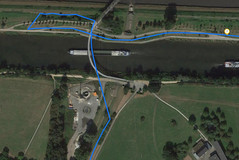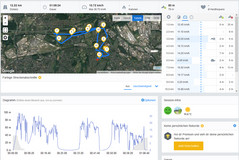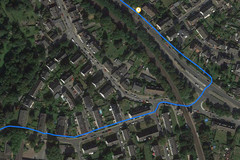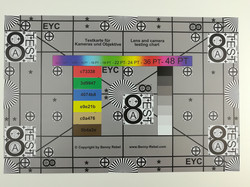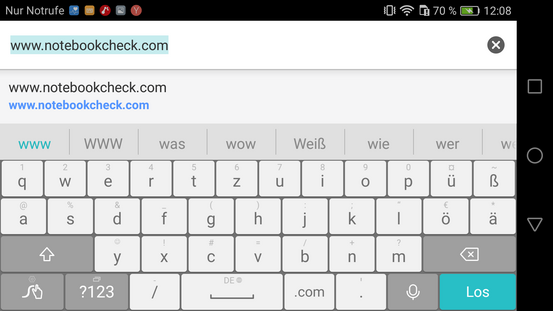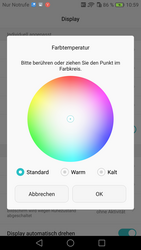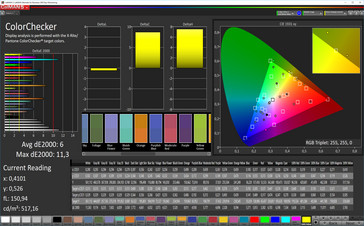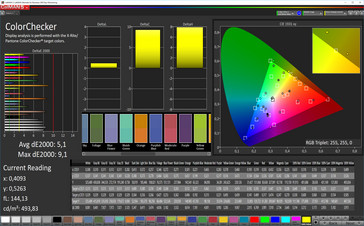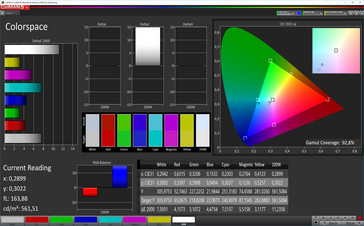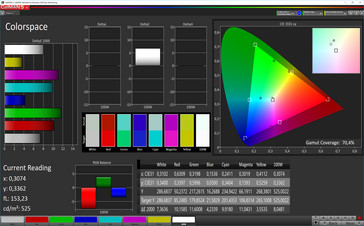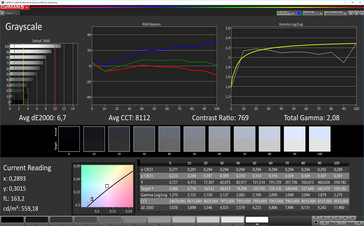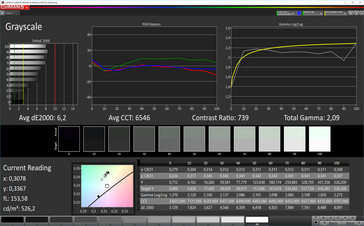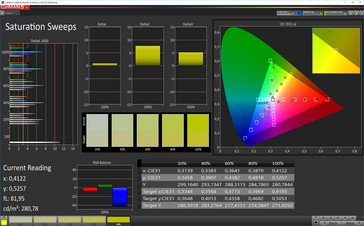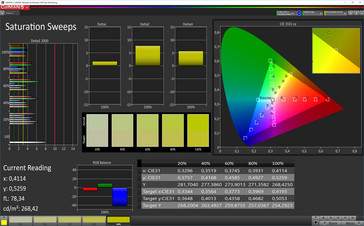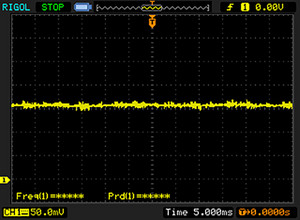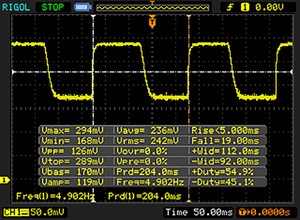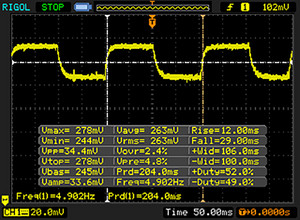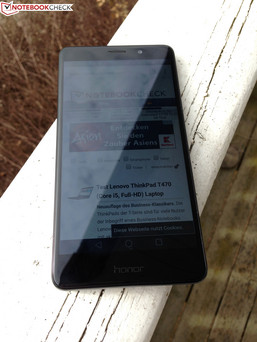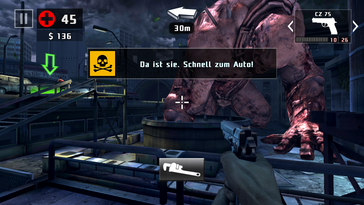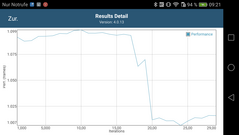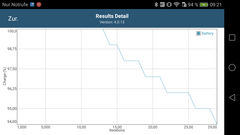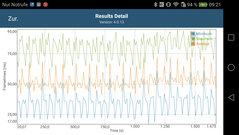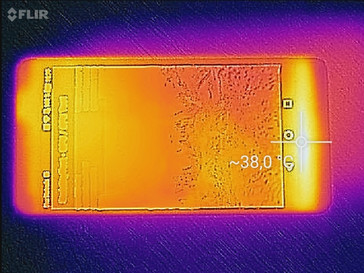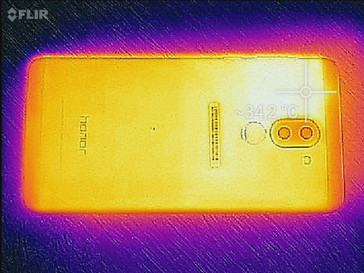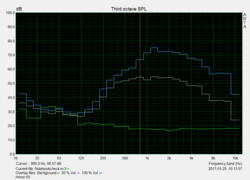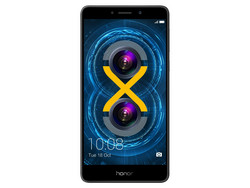Honor 6X Smartphone Review

For the original German review, see here.
It does not always have to be the latest iPhone or the premium model of Samsung's Galaxy lineup. Buyers who are not willing to spend 500 Euros (~$536) or, as is often the case, even considerably more for a high-end smartphone can find interesting alternatives in the mid-range. One of these is Honor's 6X. Huawei's subsidiary Honor officially sells its 5.5-inch smartphone for 249 Euros (~$267), which comes with an extensive configuration.
The most exciting feature of the 6X is certainly the dual camera that is normally only found in much higher-priced models. The dual camera in the 6X consists of a 12-megapixel primary camera and a second, 2-megapixel lens that captures the corresponding depth of field. This combination allows refocusing the image afterwards and images can be modified extensively. An 8-megapixel front camera completes the camera module, and provides a good diversity of selfie features.
The other configuration features of Honor's 6X are also impressive and correspond to a solid mid-range standard. The octa-core HiSilicon Kirin 655 SoC together with the integrated ARM Mali-T830 MP2 graphics chip, 3 GB of RAM, and 32-GB of storage create its base. A Full HD screen, LTE, Wi-Fi 802.11 b/g/n, Bluetooth and NFC, dual SIM support, fingerprint sensor, and a relatively up-to-date Android 6.0 operating system complement this.
Honor's 6X has also been available in the official, 319-Euro (~$342) ProKit Edition since early March. It comes with 4 GB of RAM and 64 GB of storage. A headset, a selfie stick, and a USB Type-C adapter are also included.
Our review sample, which is the standard edition of Honor's 6X, competes against its predecessor Honor 5X. The following smartphones also participate due to their similar configuration and performance: the HTC One A9s, the Huawei P8 lite, the Samsung Galaxy J7, and the Sony Xperia XA.
Case
Honor covers the 6X in a metal casing that is kept in place by a plastic frame which is of a slightly different color. Curved and scratch-resistant 2.5D glass covers the entire front and gives Honor's 6X a stylish and high-quality appearance. The 162-gram (~5.7 oz) light-weight smartphone with a thickness of just 8.2 millimeters (~0.3 in) is pleasant to hold, and needs a lot of effort to warp it.
In addition to the easy to find fingerprint sensor that is in a recess, the slightly protruding dual-camera is found on the back. The smartphone will thus rock a bit on an even surface when the display is tapped on its sides or in the corners.
Honor's 6X is available in gold, silver, and gray. The front is white in the first two cases, and it is black in the gray version.
Connectivity
Honor's 6X offers a solid configuration with HiSilicon's Kirin 655 octa-core SoC, the integrated ARM Mali-T830 MP2 graphics chip, 3 GB of RAM, and 32 GB of storage. The ProKit edition comes with 4 GB of RAM and 64 GB of storage.
The storage can be expanded by up to 128 GB via a microSD card. Moving apps to the microSD card is not possible as only media data can be saved on it. On the other hand, the smartphone supports USB OTG for connecting external peripherals.
The smartphone cannot be used in dual SIM mode when a microSD card is inserted. The slot is designed for either two nano SIM cards or one nano SIM and one microSD card. Compared with Honor, this is a step back considering that the latter has two full-fledged SIM card slots plus a microSD slot rather than a hybrid SIM slot.
Software
Android 6.0 Marshmallow runs on Honor's 6X. It is covered by Huawei's latest user interface, EMUI 4.1, familiar from other smartphones. Fortunately, the preloaded games and apps, such as "Dragon Mania", "Spider Man: Ultimate Power", Booking.com, Twitter, and Opera, are easy to uninstall if the user does not want them.
An update to Android 7.0 Nougat was in the beta-phase at the time of testing, and should be released soon. This also involves an update to EMUI 5.0.
Communication and GPS
Equipped with LTE Cat.6, Honor's 6X allows download speeds of up to 300 MBit/s and maximum upload speeds of 50 MBit/s. The smartphone's four GSM, three UMTS and six LTE bands cover all mobile network frequencies relevant for Europe.
The 6X transmits data over short distances via NFC, Bluetooth 4.1, and Wi-Fi 802.11 b/g/n. The 5.0 GHz frequency band cannot be used, and thus, even though the transmission rates are decent, they are not outstanding. At a Wi-Fi speed of up to 57.9 MBit/s, the 6X is virtually just as fast as Huawei's P8 lite that is equipped with the same SoC. Samsung's Galaxy J7 is slightly slower than both handsets, while HTC's One A9s has a clear lead with a three digit transmission rate.
| Networking | |
| iperf3 transmit AX12 | |
| HTC One A9s | |
| Honor 6X | |
| Huawei P8 lite 2017 | |
| Samsung Galaxy J7 2016 | |
| iperf3 receive AX12 | |
| HTC One A9s | |
| Honor 6X | |
| Huawei P8 lite 2017 | |
| Samsung Galaxy J7 2016 | |
Honor's 6X located us with an accuracy of 5 meters (~16 ft) indoors and outside, which is quite accurate. Thus, our expectations were also high as we took the smartphone on a roughly 12 kilometer (~704 mi) long bike ride alongside Garmin's Edge 500 professional navigation system. Honor's 6X also did a good job compared with the navigation system, although it was slightly off track in difficult sectors, such as bridges, woods or turning points. However, the difference between the two was only about 300 meters (~328 yd) over the entire route. Other smartphones might be even more accurate, but the app on Honor's 6X provides sufficient accuracy for everyday use.
Telephone and Call Quality
The phone app of Honor's 6X looks slightly different from Google's standard app due to the EMUI interface, but it ultimately provides exactly the same functions. The reception quality was good in both landline calls and via mobile network. The caller and the contact sometimes sounded a bit muffled and in high volumes voices quickly sounded shaky.
Cameras
Although Honor has officially priced the 6X at only 250 Euros (~$268), the 5.5-inch Android handset has a special feature that the former 5X did not have, and which is normally only found in considerably higher priced smartphones: A dual-camera with an aperture range of f/0.95 to f/16. Here is how it functions: A second, 2-megapixel camera is installed below the 12-megapixel primary camera, which is exclusively responsible for capturing the field of depth. This dual setup allows editing the focus of a photo manually afterward. For example, the background can be taken out of focus for bringing people or objects into the foreground more strongly.
Several convenient aids for the photographer are found in the clearly arranged camera menu, among them programs for panorama, night mode, and HDR. All relevant photo parameters such as sensitivity, white balance, and shutter time can be adjusted manually in the "Professional Photo" mode. An audio-release that either responds to "cheese" or is enabled when the ambient noise reaches a specified decibel level is also installed. A timer, object tracking, and smile detection are also found. Photos have a resolution of up to 3968x2979 pixels (4:3 format). Videos can be recorded in Full HD at 30 frames per second.
Honor has included several selfie functions in the 8-megapixel front camera, such as a 10-level touch-up filter and 9 make-up overlays. Shooting the "perfect selfie" is also possible. The user photographs several views of themselves and can narrow their face or add larger and brighter eyes as well as smoothing and softening the portrait. The front camera records video in 720p at 30 frames per second.
Honor's 6X shoots decent photos with pleasantly high dynamics and sharpness. The colors are also good - they are not too strong or too weak, and look natural and overall, at most a touch too high in terms of contrast. However, this is not perceived as a disadvantage or exaggerated. The image looks rather blurred in some places in low-light conditions, but this does not ruin the overall good impression.
We photographed ColorChecker Passport and our test chart under controlled light condition with Honor's 6X. The camera's automatic mode is used and the photo is not edited afterwards. As the ColorChecker photo illustrates, the smartphone reproduces colors quite well, even though they are always a bit too vivid.
The smartphone reproduces the test chart sharply and does not have problems with color gradients or outlines. Although the sharpness decreases toward the test chart's edges, professional cameras do not do a better job either.
Accessories and Warranty
Honor's 6X comes with a modular power supply, a USB cable, and a quick start guide. Honor does not offer any smartphone specific accessories. The manufacturer includes a 24-month warranty on the 6X. This is limited to 6 months on the battery and the charger.
Please see our Guarantees, Return Policies and Warranties FAQ for country-specific information.
Input Devices and Handling
Not only does the curved 2.5D glass surface look good, it also provides the touchscreen with good gliding properties. The screen identifies up to 10 fingers at the same time and is accurate into its four corners. Honor relies on the familiar Swype keyboard as the screen keyboard. Its layout is designed well and allows, for example, directly accessing the umlauts in the German layout. However, its many fields and functions also give a slightly cramped impression. Users can always replace the keyboard with one from Google's Play Store if preferred.
Both the physical power button and volume control make a high-quality impression. They do not have lateral play in the casing and present an accurate pressure point. The fingerprint scanner below the dual camera functions just as fast and reliably. Up to 5 fingerprints can be saved in the fingerprint manager. The sensor can also be used for accepting calls or taking a photo/video.
Display
As with its predecessor, Honor's 6X scores with a very bright Full HD panel that is even a bit higher with 540.1 cd/m² compared with the 5X. We still measured a very good 534 cd/m² using a more realistic illumination with evenly distributed bright and dark image areas. Only the company's own Huawei P8 lite rival and Sony's Xperia XA can compete here among the comparison devices, while the brightness of HTC's One A9s and Samsung's Galaxy J7 is much lower.
The IPS panel in the 6X also delivers good outcomes in contrast ratio (960:1) and black level (0.57 cd/m²). Although Honor's 5X is significantly better here, the naked eye cannot see any real differences. Honor's 6X has a clear lead in illumination. With 94%, the backlight is distributed very evenly over the screen (5X: 85%); this rate is the highest in the comparison.
| |||||||||||||||||||||||||
Brightness Distribution: 94 %
Center on Battery: 547 cd/m²
Contrast: 960:1 (Black: 0.57 cd/m²)
ΔE ColorChecker Calman: 5.1 | ∀{0.5-29.43 Ø4.78}
ΔE Greyscale Calman: 6.2 | ∀{0.09-98 Ø5}
Gamma: 2.09
CCT: 6546 K
| Honor 6X IPS, 1920x1080, 5.5" | Honor 5X IPS, 1920x1080, 5.5" | Huawei P8 lite 2017 IPS, 1920x1080, 5.2" | HTC One A9s IPS, 1280x720, 5" | Samsung Galaxy J7 2016 Super AMOLED, 1280x720, 5.5" | Sony Xperia XA IPS, 1280x720, 5" | |
|---|---|---|---|---|---|---|
| Screen | 8% | 8% | 16% | 0% | -15% | |
| Brightness middle (cd/m²) | 547 | 535 -2% | 575 5% | 348 -36% | 287 -48% | 518 -5% |
| Brightness (cd/m²) | 540 | 521 -4% | 559 4% | 320 -41% | 289 -46% | 475 -12% |
| Brightness Distribution (%) | 94 | 85 -10% | 91 -3% | 85 -10% | 91 -3% | 81 -14% |
| Black Level * (cd/m²) | 0.57 | 0.43 25% | 0.39 32% | 0.23 60% | 0.61 -7% | |
| Contrast (:1) | 960 | 1244 30% | 1474 54% | 1513 58% | 849 -12% | |
| Colorchecker dE 2000 * | 5.1 | 4.88 4% | 5.2 -2% | 3.5 31% | 2.9 43% | 6.8 -33% |
| Colorchecker dE 2000 max. * | 9.1 | 8.66 5% | 10.3 -13% | 6.4 30% | 10.1 -11% | 11.4 -25% |
| Greyscale dE 2000 * | 6.2 | 5.2 16% | 7.2 -16% | 4 35% | 2.1 66% | 7 -13% |
| Gamma | 2.09 105% | 2.26 97% | 2.4 92% | 2.3 96% | 2.05 107% | 2.35 94% |
| CCT | 6546 99% | 7766 84% | 7224 90% | 6527 100% | 6228 104% | 8151 80% |
* ... smaller is better
The color temperature can be adapted in the display settings. This can be done by either changing the default mode "Standard" to "Warm" or "Cool" or by tapping on a point in the color circle.
Examined with the photospectrometer and CalMAN software, the image parameters in the "Standard" and "Warm" profiles selected for the test clearly exceed the ideal rate (DeltaE < 3). The color temperature of 8112 K is also much too high in the "Standard" setting. On the other hand, "Warm" is almost perfect with 6546 K – actually, the two profile names should have been swapped. Overall, the deviations are acceptable for the smartphone's screen. The accuracy of Honor's 6X is roughly midfield among the comparison devices.
Screen Flickering / PWM (Pulse-Width Modulation)
| Screen flickering / PWM not detected | |||
In comparison: 53 % of all tested devices do not use PWM to dim the display. If PWM was detected, an average of 8142 (minimum: 5 - maximum: 343500) Hz was measured. | |||
Display Response Times
| ↔ Response Time Black to White | ||
|---|---|---|
| 24 ms ... rise ↗ and fall ↘ combined | ↗ 5 ms rise | |
| ↘ 19 ms fall | ||
| The screen shows good response rates in our tests, but may be too slow for competitive gamers. In comparison, all tested devices range from 0.1 (minimum) to 240 (maximum) ms. » 53 % of all devices are better. This means that the measured response time is worse than the average of all tested devices (20.2 ms). | ||
| ↔ Response Time 50% Grey to 80% Grey | ||
| 41 ms ... rise ↗ and fall ↘ combined | ↗ 12 ms rise | |
| ↘ 29 ms fall | ||
| The screen shows slow response rates in our tests and will be unsatisfactory for gamers. In comparison, all tested devices range from 0.165 (minimum) to 636 (maximum) ms. » 64 % of all devices are better. This means that the measured response time is worse than the average of all tested devices (31.7 ms). | ||
Honor's 6X is quite suitable for outdoor use, thanks to its high brightness of up to 566 cd/m². The smartphone can also be used on sunny days or in especially bright environments when reflections are avoided on the screen.
The viewing angle stability is typically high for an IPS panel. Although the screen sometimes brightens up slightly in extreme lateral views, the displayed content remains impeccably legible.
Performance
HiSilicon's Kirin 655 is an ARM-based mid-range SoC with eight Cortex A53 cores. They are divided into two clusters of 4 cores each. The first cluster takes care of performance-driven tasks and clocks at up to 2.1 GHz. The second cluster is responsible for standard tasks and clocks at 1.7 GHz. An integrated ARM Mali-T830 MP2 graphics unit supports the SoC. 3 GB of RAM complements this in our standard model. The ProKit edition has 4 GB.
Subjectively, stutters or other lags rarely occurred during use. This is reflected in the synthetic benchmarks. Overall, Honor's 6X achieves a good system performance. It clearly outruns it 5X predecessor that was based on a Qualcomm SoC and passes the finishing line as one of the fastest smartphones. It is almost in a tie with Huawei's P8 lite that also uses HiSilicon's Kirin 655 SoC. However, the lead over some rivals is very narrow. Sony's Xperia XA in particular proves to be an intractable pursuer.
| AnTuTu v6 - Total Score (sort by value) | |
| Honor 6X | |
| Honor 5X | |
| Huawei P8 lite 2017 | |
| HTC One A9s | |
| Samsung Galaxy J7 2016 | |
| Sony Xperia XA | |
| Geekbench 4.0 | |
| 64 Bit Single-Core Score (sort by value) | |
| Honor 6X | |
| Huawei P8 lite 2017 | |
| HTC One A9s | |
| Samsung Galaxy J7 2016 | |
| 64 Bit Multi-Core Score (sort by value) | |
| Honor 6X | |
| Huawei P8 lite 2017 | |
| HTC One A9s | |
| Samsung Galaxy J7 2016 | |
| GFXBench (DX / GLBenchmark) 2.7 | |
| T-Rex Onscreen (sort by value) | |
| Honor 6X | |
| Honor 5X | |
| Huawei P8 lite 2017 | |
| HTC One A9s | |
| Samsung Galaxy J7 2016 | |
| Sony Xperia XA | |
| 1920x1080 T-Rex Offscreen (sort by value) | |
| Honor 6X | |
| Honor 5X | |
| Huawei P8 lite 2017 | |
| HTC One A9s | |
| Samsung Galaxy J7 2016 | |
| Sony Xperia XA | |
| GFXBench 3.0 | |
| on screen Manhattan Onscreen OGL (sort by value) | |
| Honor 6X | |
| Honor 5X | |
| Huawei P8 lite 2017 | |
| HTC One A9s | |
| Samsung Galaxy J7 2016 | |
| Sony Xperia XA | |
| 1920x1080 1080p Manhattan Offscreen (sort by value) | |
| Honor 6X | |
| Honor 5X | |
| Huawei P8 lite 2017 | |
| HTC One A9s | |
| Samsung Galaxy J7 2016 | |
| Sony Xperia XA | |
| GFXBench 3.1 | |
| on screen Manhattan ES 3.1 Onscreen (sort by value) | |
| Honor 6X | |
| Huawei P8 lite 2017 | |
| HTC One A9s | |
| Samsung Galaxy J7 2016 | |
| Sony Xperia XA | |
| 1920x1080 Manhattan ES 3.1 Offscreen (sort by value) | |
| Honor 6X | |
| Huawei P8 lite 2017 | |
| HTC One A9s | |
| Samsung Galaxy J7 2016 | |
| Sony Xperia XA | |
| PCMark for Android - Work performance score (sort by value) | |
| Honor 6X | |
| Honor 5X | |
| Huawei P8 lite 2017 | |
| HTC One A9s | |
| Samsung Galaxy J7 2016 | |
| Sony Xperia XA | |
Honor's 6X and the comparison devices are even closer together in the browser benchmarks. Browsing on the Internet is fast with all handsets. This is also true for Honor's 5X that only falls behind slightly in the Mozilla Kraken 1.1 benchmark.
| Octane V2 - Total Score (sort by value) | |
| Honor 6X | |
| Honor 5X | |
| Huawei P8 lite 2017 | |
| HTC One A9s | |
| Samsung Galaxy J7 2016 | |
| Sony Xperia XA | |
| Mozilla Kraken 1.1 - Total (sort by value) | |
| Honor 6X | |
| Honor 5X | |
| Huawei P8 lite 2017 | |
| HTC One A9s | |
| Samsung Galaxy J7 2016 | |
| Sony Xperia XA | |
| WebXPRT 2015 - Overall (sort by value) | |
| Honor 6X | |
| Honor 5X | |
| Huawei P8 lite 2017 | |
| HTC One A9s | |
| Samsung Galaxy J7 2016 | |
| Sony Xperia XA | |
| JetStream 1.1 - Total Score (sort by value) | |
| Honor 6X | |
| Honor 5X | |
| Huawei P8 lite 2017 | |
| HTC One A9s | |
| Samsung Galaxy J7 2016 | |
| Sony Xperia XA | |
* ... smaller is better
Honor's 6X again proves to be a fast smartphone in the read and write benchmarks. It can even clearly outperform some rivals. The 5X is affected most here as it does not come even close to its successor, apart from in sequential write. Samsung's Galaxy J7 and Sony's Xperia XA are almost just as fast as Honor's 6X. However, none of the comparison devices can exhaust the performance of our Toshiba Exceria Pro M401 (max. read: 95 MB/s, max: write: 80 MB/s) reference card. Sony and Samsung's smartphones still utilize the performance best. Honor's 6X presents decent rates with 34.5 MB/s in read and 52 MB/s in write, but it is nevertheless only enough for a place in the midfield.
| Honor 6X Mali-T830 MP2, Kirin 655, 32 GB eMMC Flash | Honor 5X Adreno 405, 616 MSM8939v2, 16 GB eMMC Flash | Huawei P8 lite 2017 Mali-T830 MP2, Kirin 655, 16 GB eMMC Flash | HTC One A9s Mali-T860 MP2, Helio P10 MT6755, 32 GB eMMC Flash | Samsung Galaxy J7 2016 Mali-T830 MP1, 7870 Octa, 16 GB eMMC Flash | Sony Xperia XA Mali-T860 MP2, Helio P10 MT6755, 16 GB eMMC Flash | |
|---|---|---|---|---|---|---|
| AndroBench 3-5 | -45% | -29% | -25% | -13% | -9% | |
| Sequential Read 256KB (MB/s) | 283.4 | 144 -49% | 165.8 -41% | 210.2 -26% | 189.4 -33% | 240.4 -15% |
| Sequential Write 256KB (MB/s) | 73.8 | 78 6% | 42 -43% | 68.6 -7% | 46.24 -37% | 68.6 -7% |
| Random Read 4KB (MB/s) | 39.55 | 17 -57% | 38.7 -2% | 21.3 -46% | 22.33 -44% | 22.05 -44% |
| Random Write 4KB (MB/s) | 45.05 | 10 -78% | 8 -82% | 34.6 -23% | 10.11 -78% | 10.6 -76% |
| Sequential Read 256KB SDCard (MB/s) | 52 | 53.1 2% | 39.6 -24% | 75.5 45% | 72.9 40% | |
| Sequential Write 256KB SDCard (MB/s) | 34.53 | 32.1 -7% | 25.6 -26% | 58.2 69% | 50.7 47% |
Games
It is possible to play up-to-date Android games smoothly on Honor's 6X, but not always in maximum details. Only an average of 25 frames per second was achieved in the highest detail level in the demanding "Asphalt 8: Airborne". An occasional stutter in some scenes made this evident. On the other hand, there were no performance losses in "Dead Trigger 2" that ran quite smoothly even in maximum details. Touchscreen and position sensor control functioned impeccably.
| Asphalt 8: Airborne | |||
| Settings | Value | ||
| high | 25 fps | ||
| very low | 30 fps | ||
| Dead Trigger 2 | |||
| Settings | Value | ||
| high | 57 fps | ||
Emissions
Temperature
Honor's 6X heated up to a maximum of 37.5 °C (~99.5 °F) even after a one-hour stress test with the Stability Test app, which is hardly more than lukewarm. It was an average of 33.8 °C (~93 °F) on the upper side and underside during load and just 29.4 °C (~85 °F) while idling.
We examined whether Honor's 6X throttles due to too high internal temperatures with the GFXBench battery test. Here, the T-Rex game scene is rendered thirty times in succession. The frame rate remained stable up to about the 17th run before it started to decrease slightly. However, the reduction was so slight that we cannot speak of throttling or a real performance fluctuation.
(+) The maximum temperature on the upper side is 37.5 °C / 100 F, compared to the average of 35.2 °C / 95 F, ranging from 21.9 to 247 °C for the class Smartphone.
(+) The bottom heats up to a maximum of 32.5 °C / 91 F, compared to the average of 34 °C / 93 F
(+) In idle usage, the average temperature for the upper side is 30.2 °C / 86 F, compared to the device average of 32.9 °C / 91 F.
Speaker
The mono speaker in Honor's 6X can reach a volume of 81.9 dB(A), but it sounds tinny and tends to distort quickly at maximum volume. Not much bass is audible in any volume setting. On the other hand, the high tones are all the more present, which could become strenuous in long music pieces or videos.
The sound quality is significantly better via the 3.5-mm jack and Bluetooth connection. However, a headset is not included.
Honor 6X audio analysis
(±) | speaker loudness is average but good (81.9 dB)
Bass 100 - 315 Hz
(-) | nearly no bass - on average 21.7% lower than median
(±) | linearity of bass is average (10.2% delta to prev. frequency)
Mids 400 - 2000 Hz
(±) | higher mids - on average 8.4% higher than median
(±) | linearity of mids is average (7.8% delta to prev. frequency)
Highs 2 - 16 kHz
(±) | higher highs - on average 6.7% higher than median
(+) | highs are linear (5.8% delta to prev. frequency)
Overall 100 - 16.000 Hz
(±) | linearity of overall sound is average (29.1% difference to median)
Compared to same class
» 76% of all tested devices in this class were better, 3% similar, 21% worse
» The best had a delta of 11%, average was 35%, worst was 134%
Compared to all devices tested
» 87% of all tested devices were better, 2% similar, 11% worse
» The best had a delta of 4%, average was 24%, worst was 134%
Honor 5X audio analysis
(+) | speakers can play relatively loud (88.2 dB)
Bass 100 - 315 Hz
(-) | nearly no bass - on average 25.7% lower than median
(±) | linearity of bass is average (11.5% delta to prev. frequency)
Mids 400 - 2000 Hz
(±) | higher mids - on average 6.5% higher than median
(±) | linearity of mids is average (7.5% delta to prev. frequency)
Highs 2 - 16 kHz
(±) | higher highs - on average 12% higher than median
(+) | highs are linear (6% delta to prev. frequency)
Overall 100 - 16.000 Hz
(±) | linearity of overall sound is average (29.7% difference to median)
Compared to same class
» 77% of all tested devices in this class were better, 4% similar, 19% worse
» The best had a delta of 11%, average was 35%, worst was 134%
Compared to all devices tested
» 87% of all tested devices were better, 3% similar, 10% worse
» The best had a delta of 4%, average was 24%, worst was 134%
Huawei P8 lite 2017 audio analysis
(+) | speakers can play relatively loud (83.6 dB)
Bass 100 - 315 Hz
(-) | nearly no bass - on average 32.1% lower than median
(±) | linearity of bass is average (11.2% delta to prev. frequency)
Mids 400 - 2000 Hz
(+) | balanced mids - only 4% away from median
(+) | mids are linear (6.4% delta to prev. frequency)
Highs 2 - 16 kHz
(±) | higher highs - on average 7.9% higher than median
(+) | highs are linear (4.8% delta to prev. frequency)
Overall 100 - 16.000 Hz
(±) | linearity of overall sound is average (27.6% difference to median)
Compared to same class
» 71% of all tested devices in this class were better, 5% similar, 24% worse
» The best had a delta of 11%, average was 35%, worst was 134%
Compared to all devices tested
» 84% of all tested devices were better, 3% similar, 13% worse
» The best had a delta of 4%, average was 24%, worst was 134%
Frequency diagram in comparison (checkboxes above can be turned on/off!)
Energy Management
Power Consumption
Honor's 6X presents itself as quite restrained in terms of power consumption. It is considerably more energy efficient than Honor's 5X with almost 5 watts in full load. Only Samsung's Galaxy J7 is even more economical among the comparison devices. Furthermore, Honor's 6X has the best requisites for a long battery life as it has the highest capacity battery. Unfortunately, we cannot make any statements concerning the charging time since a charger was not included with our review sample.
| Off / Standby | |
| Idle | |
| Load |
|
Key:
min: | |
| Honor 6X 3340 mAh | Honor 5X 3000 mAh | Huawei P8 lite 2017 3000 mAh | HTC One A9s 2300 mAh | Samsung Galaxy J7 2016 3300 mAh | Sony Xperia XA 2300 mAh | |
|---|---|---|---|---|---|---|
| Power Consumption | -21% | -38% | -27% | 21% | 7% | |
| Idle Minimum * (Watt) | 0.82 | 0.87 -6% | 1.44 -76% | 1.29 -57% | 0.67 18% | 0.72 12% |
| Idle Average * (Watt) | 2 | 2.08 -4% | 2.47 -24% | 2.28 -14% | 1.71 14% | 1.5 25% |
| Idle Maximum * (Watt) | 2.03 | 2.22 -9% | 2.58 -27% | 2.52 -24% | 1.83 10% | 1.57 23% |
| Load Average * (Watt) | 3.34 | 5.26 -57% | 4.55 -36% | 4.06 -22% | 2.37 29% | 3.48 -4% |
| Load Maximum * (Watt) | 4.92 | 6.34 -29% | 6.3 -28% | 5.91 -20% | 3.31 33% | 6.04 -23% |
* ... smaller is better
Battery Runtime
The non-removable lithium polymer battery in Honor's 6X has a capacity of 3340 mAh, which is 340 mAh more than that of Honor's 5X. According to the manufacturer, this is enough for over 2 days of moderate use and even 1.5 days of intense use. However, Honor does not define what "moderate" and "intense" exactly mean and thus there is plenty of room for speculation. Our battery tests show that the smartphone has altogether enough reserves to achieve these runtimes in practice.
Honor's 6X shut down after almost 16 hours in the realistic Wi-Fi test. It still lasted on average for over 14:45 hours when playing an H.264 video. Thus, it proves to be a real endurance device that could easily last one or two workdays away from an outlet. Only Samsung's Galaxy J7 lasts even longer. The other rivals all have to line in behind them. Honor's 5X and Sony's Xperia XA come in last with approximately half the runtime of the 6X on average.
| Honor 6X 3340 mAh | Honor 5X 3000 mAh | Huawei P8 lite 2017 3000 mAh | HTC One A9s 2300 mAh | Samsung Galaxy J7 2016 3300 mAh | Sony Xperia XA 2300 mAh | |
|---|---|---|---|---|---|---|
| Battery runtime | -45% | -33% | -37% | 29% | -58% | |
| Reader / Idle (h) | 37.5 | 17.6 -53% | 22.1 -41% | 25.7 -31% | 33.8 -10% | 12.9 -66% |
| H.264 (h) | 14.8 | 10 -32% | 10.7 -28% | 9.8 -34% | 20.3 37% | 7.7 -48% |
| WiFi v1.3 (h) | 16 | 10.7 -33% | 10.1 -37% | 8.6 -46% | 17.1 7% | 5.9 -63% |
| Load (h) | 6.3 | 2.4 -62% | 4.7 -25% | 4.1 -35% | 11.4 81% | 2.8 -56% |
Pros
Cons
Verdict
Honor has a well-conceived total package in its lineup with the 5.5-inch 6X. At an official price of 249 Euros (~$268), the buyer gets a fast mid-range smartphone with a high-quality build that does many things better than its predecessor 5X, and which convinces with its decent configuration.
Foremost among these is definitely the dual-camera with its movable focus - a feature that is normally found in considerably more expensive smartphones. The Full HD panel, LTE Cat.6, NFC, dual SIM support, and 32 GB of storage, of which 22.9 GB can be used, are further plus points. Honor's 6X can easily last two days in a row, thanks to its strong battery.
Honor's 6X combines its low price with a configuration that is almost worthy of the premium class.
However, the low price also involves making some compromises: Honor's 6X only transmits in the 2.4 GHz Wi-Fi and achieves good but not outstanding transmission rates. Furthermore, up-to-date games do not always run smoothly when the details are set to maximum despite, an octa-core SoC and 3 GB of RAM. The mono speaker sounds mediocre at most and unfortunately calls also sound muffled every now and again.
Not really a minus point, but nevertheless an important detail: Honor's 6X still used Android 6.0 at the time of testing. However, an update to Android 7.0 has been announced and should be rolled out within the next few weeks.
Honor 6X
- 03/06/2017 v6 (old)
Manuel Masiero




